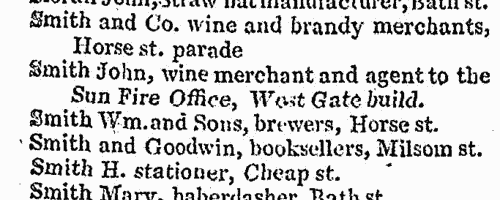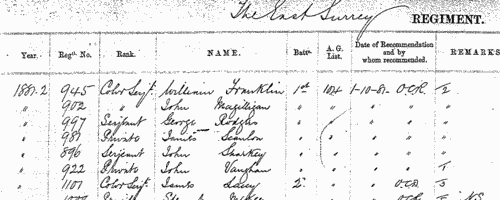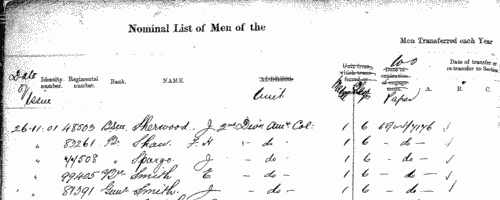Mcilveen Surname Ancestry ResultsOur indexes 1800-1900 include entries for the spelling 'mcilveen'. In the period you have requested, we have the following 9 records (displaying 1 to 9): Buy all | | | Get all 9 records to view, to save and print for £56.00 |
These sample scans are from the original record. You will get scans of the full pages or articles where the surname you searched for has been found. Your web browser may prevent the sample windows from opening; in this case please change your browser settings to allow pop-up windows from this site. Inhabitants of Belfast
(1805)
Holden's Triennial Directory of 1805 to 1807 included a provincial section, listing professional people and traders in England, Wales, Scotland and Ireland. (The sample scan here is from the listing for Bath)MCILVEEN. Cost: £6.00.  | Sample scan, click to enlarge

| Inhabitants of Birmingham
(1850)
Francis White & Co.'s History, Gazetteer, and Directory of Warwickshire for 1850 lists nobility, gentry, clergy, other private residents, farmers and traders, hundred by hundred and village by village, with separate sections for the large towns. This long alphabetical section lists inhabitants of Birmingham.MCILVEEN. Cost: £4.00.  | Sample scan, click to enlarge

| Inhabitants of Leeds, Yorkshire
(1853)
William White's directory lists traders, farmers and private residents in the area. MCILVEEN. Cost: £6.00.  | Sample scan, click to enlarge

| Irish Debtors and Bankrupts
(1880)
Bills of sale (binding assets to a creditor/lender), and bankruptcies in Ireland, October to December 1880MCILVEEN. Cost: £6.00.  | Sample scan, click to enlarge

| Irish Debtors and Bankrupts
(1881)
Bills of sale (binding assets to a creditor/lender), and bankruptcies in Ireland, January to March 1881MCILVEEN. Cost: £6.00.  | Sample scan, click to enlarge

| Debtors, Insolvents and Bankrupts
(1887)
Bills of sale (binding assets to a creditor/lender), insolvencies and bankruptcies in England and Wales, April to June 1887MCILVEEN. Cost: £6.00.  | Sample scan, click to enlarge

| Inhabitants of county Armagh
(1888)
Bassett's Book of Antrim is a directory listing traders, farmers and private residents in the county, with notes on local manufacture and for anglers and sportsmen.MCILVEEN. Cost: £6.00.  | Sample scan, click to enlarge

|  Outstanding soldiers of the Seaforth Highlanders (Ross-shire Buffs, The Duke of Albany's)
(1881-1901) Outstanding soldiers of the Seaforth Highlanders (Ross-shire Buffs, The Duke of Albany's)
(1881-1901)
Each year the best soldiers of the regiment were chosen for long service and good conduct medals. This register gives rank, name, regimental number, and date of recommendation. (The sample scan is from the East Surrey regiment). The register is essentially a register of recommendations, annotated with details of the issue of the medals. Where no gratuity accompanied the medal, the entry is marked 'W. G.' (without gratuity); where, for one reason or another, the medal was not issued, the entry is marked 'N. S.' (not sanctioned) and struck through. The regiment was based on the 72nd Regimental District - Fort George. The 1st battalion moved from India to Aden 25 February 1882, and arrived in Egypt 2 August 1882, taking part in the Egyptian war, and adding "Egypt, 1882" and "Tel-el-Kebir" to the regimental honours. It returned to England 15 October 1882, and was stationed at Parkhurst. In 1886 it was transferred to Scotland; in 1889 to Ireland (based at Tipperary); in 1895 back to England, and in 1897 was sent off to Malta to take part in the occupation of Crete. From there it was transferred to Egypt for the Soudan campaign of 1898 ("Khartoum" and "Atbara"). The 2nd battalion embarked for Bombay in 1879, and by 1885 was based at Lucknow; and by 1895 at Ferozepore. It took part in the Hazara Relief Force of 1891 and the Chitral Relief Force of 1895 ("Chitral"). Having returned to England in 1897, the battalion was sent to South Africa in 1899, where it gained the honours "South Africa, 1899-1902" and "Paardeberg".MCILVEEN. Cost: £8.00.  | Sample scan, click to enlarge

|  British artillerymen fighting in South Africa
(1899-1902) British artillerymen fighting in South Africa
(1899-1902)
The Queen Victoria's South Africa Medal was awarded (after her death, in the event) to all who had served honourably in the various campaigns in the Boer War. Returns were made from each unit, and consolidated into nominal roll, of which this is the one for the Royal Artillery. Confusingly, the ledgers used had originally been printed for a register of men transferred (or re-transferred after mobilization) to 1st Class Army Reserve. All the original column headings were therefore struck through, and the roll was prepared with this information: Date of Issue; Regimental Number; Rank; Name; Unit; Medal (a 1 indicating that a medal was awarded); [number of] Clasps; the reference to the source in the original returns, usually starting with AG for papers in the hands of the Adjutant-General, and 68/Art/ for the Royal Artillery records. The final column, normally left blank, was occasionally used for explanatory remarks.MCILVEEN. Cost: £8.00.  | Sample scan, click to enlarge

|
Research your ancestry, family history, genealogy and one-name study by direct access to original records and archives indexed by surname.
|












